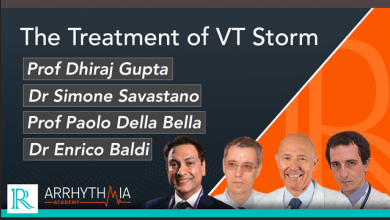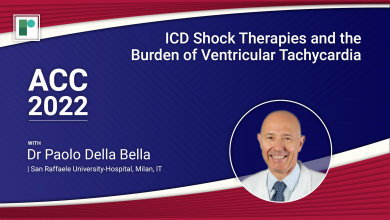Search results
Author(s):
Pok Tin Tang
,
Duc H Do
,
Anthony C Li
,
et al
Added:
3 years ago
Ventricular arrhythmias remain a major contributor to cardiac morbidity and mortality worldwide, despite ongoing research and implementation of novel therapeutic interventions. Modern management of patients with ventricular arrhythmias requires a multidisciplinary team approach, especially in complex presentations with a background of multiple medical comorbidities.1,2 Such teams may include…
View more
Device-Based Approaches to Modulate the Autonomic Nervous System and Cardiac Electrophysiology
Author(s):
William J Hucker
,
Jagmeet P Singh
,
Kimberly Parks
,
et al
Added:
3 years ago
Article
Author(s):
Josef Kautzner
,
Petr Peichl
Added:
3 years ago
Ventricular fibrillation (VF) is a complex arrhythmia that leads invariably to cardiac arrest. Its mechanisms remain largely unclear. Similar to atrial fibrillation, the mother rotor hypothesis is one plausible alternative.1,2 In larger animals, some authors reported that the dominant frequency of VF could be recorded at a junction of the left ventricular posterior wall and the septum.3-6 Others…
View more
Author(s):
Dhiraj Gupta
,
Paolo Della Bella
,
,
et al
Added:
3 years ago
VT electrical storm is a life-threatening event and an acute clinical emergency.
This edition of Arrhythmia Academy's Journal Club, moderated by Prof Dhiraj Gupta, features an interesting panel discussion with the lead authors of two recently published papers on the topic.
Prof Della Bella provides us with an overview of treatment options for VT storm using a multi-disciplinary approach.
…
View more
Author(s):
Justine Bhar-Amato
,
William Davies
,
Sharad Agarwal
Added:
3 years ago
Ventricular tachyarrhythmias (VAs) most commonly occur early in ischaemia, and patients presenting with an acute MI and ventricular arrhythmias are a group that has a significantly increased risk of mortality.1,2 Thrombolysis primary percutaneous coronary intervention (PCI) and use of beta-blockers, while resulting in the modification of the natural history of an infarct, have also reduced the…
View more
Author(s):
Roland R Tilz
,
Charlotte Eitel
,
Evgeny Lyan
,
et al
Added:
3 years ago
Ventricular tachycardia (VT) is associated with increased mortality in patients with a history of MI. ICD implantation is currently the standard of care for the prevention of sudden cardiac death, and contributes to a reduction of total mortality.1 Despite effective treatment of ventricular arrhythmias with the use of anti-tachycardia pacing (ATP) or shocks, ICDs do not prevent VT. Furthermore,…
View more
Author(s):
Paolo Della Bella
Added:
2 years ago
In this short interview from ACC.22, Dr Paolo Della Bella (San Raffaele University-Hospital, IT) joins us to discuss the findings of the PARTITA trial (NCT01547208). The aim of this study was to determine whether the burden of ventricular tachycardia correlates with ICD shock therapies and if the timing of VT ablation affects patient prognosis.
Discussion Points:
Rationale behind this trial
…
View more
Author(s):
Rahul K Mukherjee
,
Louisa O’Neill
,
Mark D O’Neill
Added:
3 years ago
Recurrent ventricular tachycardia (VT) in patients who have an implantable cardioverter-defibrillator (ICD) with subsequent shocks is associated with reduced quality of life and an adverse prognosis. Pharmacological treatments are associated with significant side-effects. Catheter ablation has been used to reduce the number of ICD therapies in patients with ischaemic and non-ischaemic…
View more
Author(s):
Mouhannad M Sadek
,
Robert D Schaller
,
Gregory E Supple
,
et al
Added:
3 years ago
Scar-related reentrant ventricular tachycardia (VT) may be present in a variety of structural heart disease (SHD) phenotypes. In this setting, VT circuits are comprised of viable myocytes separated by fibrosis, allowing for the slow conduction needed to facilitate reentry.1,2 Aetiologies of fibrosis include ischaemic heart disease (IHD), inflammatory conditions, infiltrative cardiomyopathy,…
View more
Author(s):
Eyal Nof
,
William G Stevenson
,
Roy John
Added:
3 years ago
Sustained ventricular tachycardia (VT) and ventricular fibrillation (VF) are typically a manifestation of significant structural heart disease and often associated with a high risk of sudden cardiac death. Implantable cardioverter defibrillators (ICDs) remain the mainstay of therapy for prevention of sudden cardiac death associated with these arrhythmias.1 However, ICDs treat the arrhythmia after…
View more














